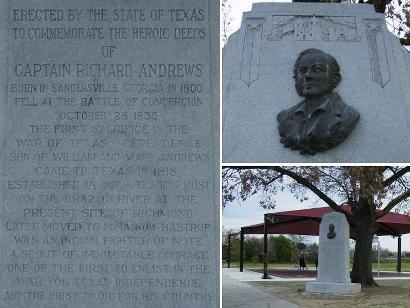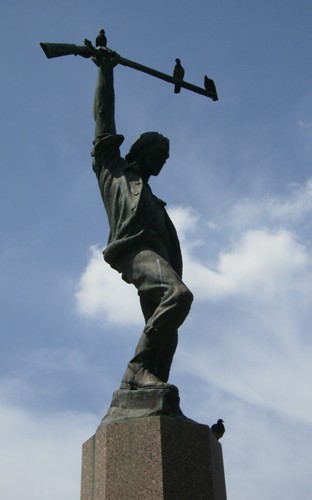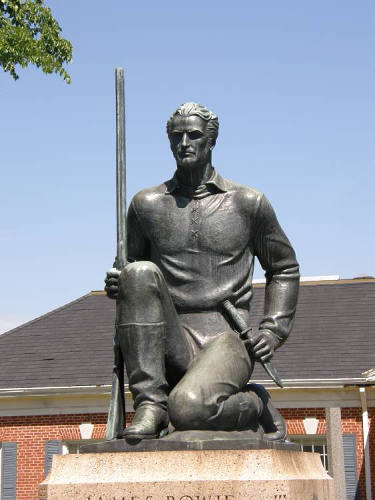|
Books by
Jeffery Robenalt
|
|
|
On
October 2, 1835, the Texas “shot heard round the world” was
fired in a brief skirmish between Mexican troops and Texas settlers
known as the Battle
of Gonzales. Two days after the victory, Stephen
F. Austin reported to the San Felipe de Austin Committee of
Public Safety that “War is declared … public opinion has proclaimed
it …” Mexican troops withdrew to San
Antonio, but volunteers from all over central
Texas continued to gather in Gonzales
. On October 11, the patriots unanimously elected Stephen
Austin to command the “Army of the People.”
|
|
|
Martin Perfecto de Cos
Wikimedia Commons |
|
Austin
was more of a statesman than a soldier, but he was eager to fight,
and he marched his army toward San
Antonio de Bexar on the morning of October 13. His force
soon grew to nearly 400 strong. They would face more than 700 well
trained Mexican soldiers under the command of General Martin Perfecto
de Cos, the brother-in-law of Dictator Santa Anna.
|
"Mission
of Concepcion, Valley of the Bexar"
1854 engraving from "Gleason's Pictorial Drawing-Room Companion"
Courtesy Sarah
Reveley |
O
n
October 27, Austin
ordered Jim Bowie and James Fannin to take 90 men and locate a defensible
position somewhere near San
Antonio for the Texas army to set up camp. Bowie and Fannin
were to return immediately after locating the site and report to
Austin.
Late in the afternoon, the Texans selected a campsite along the
San Antonio River about 500 yards west of Mission Concepcion, approximately
2 miles from San Antonio
de Bexar.
However, instead of returning to Austin
and the main body of the army as their orders specified, Bowie and
Fannin posted pickets along the river and in the mission tower,
then set up camp for the night. Realizing that the Texans had foolishly
divided their forces, General Cos ordered Colonel Domingo Ugartechea
and 275 men to launch an early-morning attack.
|
|
|
James W. Fannin
Wikimedia Commons |
| Although outnumbered
three to one, the Texans had selected an excellent defensive position
located in the trees on a horseshoe bend of the river. The big bend
provided a natural crossfire, and the trees allowed the Mexican cavalry
little room to maneuver, limiting Ugartechea to the use of his infantry.
The range of the Texans’ long rifles also far exceeded that of the
Mexican Brown Bess muskets, and the gunpowder the Texans used was
of a much finer grade. After several Mexican assaults were repelled
with heavy losses, Colonel Ugartechea ordered a withdrawal. Austin
and the remainder of the Texas army arrived 30 minutes later. |
|
|
James Bowie
Wikimedia Commons |
| Austin
was convinced that Mexican morale would be at low ebb after suffering
a defeat by such inferior numbers, and he was in favor of launching
an immediate assault on Bexar. However, Bowie and the other Texas
officers talked him out of this strategy, believing that the town
was too heavily fortified. Towards evening, Austin
permitted the Mexicans to remove their dead from the battlefield;
estimates of the dead range from 14 to 76. Richard Andrews was the
only Texan killed and one man was wounded. |
 |
|
On
November 1, Stephen
Austin sent a message to General Cos suggesting that he surrender,
but the General returned the message unopened with a message of
his own, stating that he refused to correspond with rebels. After
a reconnaissance of the town revealed fortifications were stronger
than the Texans believed,
Austin called for a council of war. The council voted to lay
siege to Bexar, and
to wait for more reinforcements and artillery before launching an
attack. Many of the undisciplined volunteers, impatient with the
war council’s decision, did not hesitate to voice their displeasure,
and Austin
complained to the provisional government in San
Felipe about their undisciplined and drunken behavior.
|
|
|
Thomas Jefferson Rusk
Wikimedia Commons |
|
Texas reinforcements
soon arrived under the command of Thomas J. Rusk, bringing up the
strength of the volunteer army to 600. However, General Cos also
received additional troops, and his forces now totaled 1200. In
addition, the Mexicans fortified the town square and placed cannons
on the walls of the Alamo,
an old mission on the outskirts of town. In light of these developments,
most of the Texas officers believed they had little choice but to
continue the siege.
Meanwhile,
Sam Houston
arrived in San
Felipe de Austin from recent treaty talks with the Cherokees,
expecting to find a gathering of the Consultation. When he discovered
most of the delegates were off fighting in the siege of Bexar, he
decided to join them. Upon his arrival, Stephen
Austin offered Houston
command of the Army of the People, but he declined. Houston understood
that it was far more important to chart the future course of Texas
and establish a provisional government than it was to throw General
Cos and his troops out of San
Antonio. After Houston
gathered the members of the Consultation, they were released from
the army and returned to San
Felipe to continue their deliberations.
Once the Consultation reconvened, the delegates voted to uphold
the Constitution of 1824, rather than move too quickly toward
independence. This angered many of the hot-bloods eager for independence,
but most of the delegates were not yet ready to burn their bridges.
After the crucial vote was cast, Sam
Houston was named general-in-chief of all Texas forces except
the men fighting in San
Antonio, and Stephen
F. Austin was designated to travel to the United States to rally
support for the Texas cause; a position for which he was eminently
suited. Edward Burleson, Austin’s second-in-command, was elected
Major General and placed in command of the troops at San
Antonio.
As the Consultation continued to struggle over the issue of independence,
the siege of San Antonio
dragged on, and the Army of the People began to slowly dissolve.
Since most of the men were farmers and ranchers and no fighting
was taking place, they simply drifted away and returned home to
work their farms and protect their families. To make matters worse,
the Texans were soon humiliated at what came to be known as the
Grass Fight.
|
|
|
Deaf Smith
Wikimedia Commons |
|
On
November 26, Erastus
“Deaf” Smith, one of Burleson’s scouts, arrived with news that
a column of Mexican soldiers was approaching Bexar
leading a train of pack horses and mules. The Texans suspected that
the pack animals were carrying a payroll of silver for the Mexican
troops. However, when a hurried attack was organized and carried
out against the column, it was discovered that the pack train was
carrying nothing but grass to feed the Mexican horses.
Discouraged with the boredom of what appeared to be an endless siege,
most Texans were ready to give up and head home, when they received
some welcome intelligence from a few Bexar
citizens. According to the helpful residents, the morale of the
Mexican soldiers was low, and they were beginning to run out of
supplies. Eager to fight, Ben
Milam came to his feet at a meeting called to discuss the situation
and loudly demanded, “Who will go into San
Antonio with old Ben Milam?”
Three hundred men, who were just as angry as Milam
and more than ready to fight, came to their feet with a roar of
approval.
|
 |
|
The
long-awaited attack was launched on December 5. Hendrick
Arnold, a mixed-race free man, led Ben
Milam’s division into battle and was praised for his valorous
service. One of the first Texans to fall was Milam
himself, who later died of his wounds. A free African American,
Greenbury Logan, was wounded shortly after Milam
fell, suffering injuries that left him disabled. The fighting proved
to be close and fierce, as the equally matched opponents struggled
from house-to-house for control of the town. Casualties continued
to mount on both sides as the battle raged on.
|
 |
After five
days of hard fighting, the bloody struggle finally came to a close,
when General Cos ordered his men to lay down their arms and hoist
the white flag. According to the terms of surrender, the General agreed
to turn over all the money, supplies, arms, and property held by the
Mexicans. He also pledged to never again oppose the Constitution of
1824. In exchange, Cos was permitted to lead his soldiers out of Texas.
Naively believing that the crisis had come to an end, most Texans
went home to celebrate their hard won victory. However, General Santa
Anna was determined to hold Texas for Mexico. He immediately set out
to gather a large army south of the Rio Grande in preparation for
a march north to punish the Texas revolutionaries. The stage was now
set for the epic Battle
of the Alamo.
© Jeffery
Robenalt,
December 30, 2011 Column
jeffrobenalt@yahoo.com
About Jeffery Robenalt
More "A Glimpse of Texas Past"
References: |
References
for The Siege of San Antonio de Bexar
|
|
Barker, Eugene
Campbell (1985), The Life of Stephen F. Austin, Founder of Texas,
1793-1836, Austin TX: University of Texas Press, ISBN 0-292-78421-X,
originally published 1926 by Lamar & Burton.
Barr, Alwyn
(1990), Texans in Revolt: the Battle for San Antonio, 1835,
Austin, TX: University of Texas Press, ISBN 0292770421, OCLU 20354408.
Davis, William
C. (2006), Lone Star Rising, College Station, TX: Texas A&M
University Press, ISBN 9781585445325, originally published 2004
by New York: Free Press.
Edmondson,
J.R. (2000), The Alamo Story-From History to Current Conflicts,
Plano, TX: Republic of Texas Press, ISBN 1-55622-678-0, OCLU 42842410.
Fehrenbach,
T.R. (2000), Lone Star: A History of Texas and Texans, Cambridge:
Da Capo Press, ISBN 0-306-80942-7.
Groneman, Bill
(1998), Battlefields of Texas, Plano, TX: Republic of Texas
Press, ISBN 9781556225710, OCLU 37935129.
Hardin, Stephen
L. (1999), Texian Iliad - A Military History of the Texas Revolution,
Austin, TX: University of Texas Press, ISBN 0292730861, OCLU 29704011.
Roell, Craig
H. (1994), Remember Goliad! A History of La Bahia, Fred Rider
Cotten Popular History Series, Austin, TX: Texas State Historical
Association, ISBN 087611141X, OCLU 30667624.
Winders, Richard
Bruce (2004), Sacrificed at the Alamo: Tragedy and Triumph in
the Texas Revolution, Military History of Texas Series: Number
Three, Abilene, TX: State House Press, ISBN 1880510804.
|
|
|
